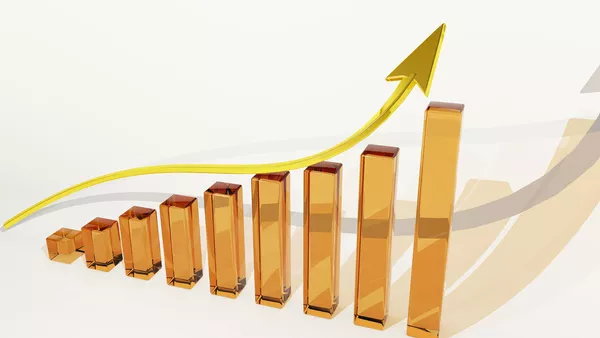So this week, we're going to address the golden question - what's it going to cost me to have the website of my dreams? You know what you need, but now you have to know what you need to budget and whether you'll get value for money - or even whether you can afford the spend at all. Let's start by talking purely about the cash...

What's a realistic budget?
See that piece of string over there?
Ok, we're being facetious - but the answer to this question can be vastly different for each and every project. The 2 key things that will make the largest impact on the cost will be scope and risk. Lets break these down:
Scope
- This can be the difference between delivering a 5 page, basic brochure site, which could be designed and built in a matter of days, to a fully functioning e-commerce shop or event management system that could take a few weeks, or even an enterprise-level back-office solution for thousands of people to continually use in their day-to-day business processes, which may take several months to build.
- The size of web projects can vary dramatically depending on requirements (see the first part in this series about your business requirements - if you've done your homework, you'll already know approximately where you are on this scale).
- The bigger the solution, the bigger the costs - so you might want to revise that part 1 again and get to the real nitty gritty of what you need. What is your 'minimum viable product'? What are the 'must-haves', 'should-haves' and 'nice-to-haves'? It's possible that the web team you're working with can release your basic site, with enough features to start returning on your investment, until you're ready to take that to a second phase of development to accelerate things further, and it could still be a vast improvement on what is there today (which could be doing you more harm than good, if it's not responsive for mobiles, for example).
- The thing to bear in mind with scope, is that the more functionality you require in order to fulfil your business needs and your brief, not only will there be more to build, but also more to test and to maintain. There will also be a larger amount of 'unknowns' that will surface once the build commences on your project. A good web team will advise how best to handle this, and will plan for it up front rather than praying that the specification is 100% perfect, or blindly driving on, delivering what's in the specification even though it may not be quite what you want (trust us, on a complex set of requirements, a perfect specification is impossible - there will be questions and refinements that come up, and so there should be!).
- However - if you do have a long list of requirements, then speak to your web team, as what seems complex to you may not actually be complex to them, and vice versa.
Risk
- How business critical your site is, how robust it needs to be, and how complex you need it to be will all dictate the risk level - you need to ensure that you have the appropriate level of planning and support to mitigate those risks.
- There's also uptime and performance to consider - the sort of hosting you may need for a fairly basic site with a thousand visitors a month will be very different to the sort of hosting you'll need for a business critical system that has thousands of users a day.
- For a very high-availability site, you may also need uptime monitoring, and 'self-healing' scripts set up, or you could need a 'load balanced' system (where, if one server goes down for any reason, another jumps in immediately to take its place, all seamless to the user).
- You may also want the security of having a web team at the end of a phone, available to help whenever you need them, or a certain amount of their time each month secured for some website analysis, to check that your site is performing how you expect.
So it's clear - both these factors will have the biggest effect on the cost. That and of course finding a web team who you feel are the right team for the job (see part 2 of this series), and whose daily rate seems reasonable to you for the value and skills they provide.
But there's a third key piece you need to consider which will put that cost in context. The all-important 'ROI', or 'Return On Investment'.
The question should really be, 'How long will it take for me to see a return on my investment?'

What does ROI really mean to me when it comes to my web project?
If you know your requirements, and you are clear about what the absolute key problems are that your website needs to solve (you should be after part 1 of this series!), then you can start talking about value, rather than cost. So the question should really be, "How long will it take for me to see a return on my investment?". That return will relate directly to the business goals for your website, which we outlined right at the beginning of this series. It depends how much you have available to invest, all web agencies will appreciate that - but essentially it comes down to how well you understand your requirements and what you think the growth generated by the website will be, versus the cost.
Here are three examples (descriptions and data have been changed to protect the innocent… but % increases are the same!).
Example 1
This model shows the 'before' and 'after' for the creation of a small, simple, re-designed and re-branded responsive 5 page website, with basic news, case study and FAQ capabilities, search engine optimised.
- Cost of site build: £999
- ROI: increase in website traffic of 1200% (with a 560% increase in sessions from mobile devices), resulting in an uplift of 220% additional sales enquiries per month
- Break-even: Within 3 months
Example 2
This model shows the 'before' and 'after' for the creation of a re-vamped, responsive catalogue website with some additional pieces of functionality such as detailed search engine optimisation, advanced product finder and downloadable materials.
- Cost of site build: £17,000
- ROI: increase in website traffic of 320% (with a 200% increase in sessions from mobile devices), resulting in 2-3 new large B2B accounts onboarded per month (large value)
- Break-even: Within 6 months
Example 3
This model shows the 'before' and 'after' for the creation of a mission-critical internal back-office system which stores, shares and gives easy, secure access to pdf documents and a large database of other information, enables bookings, entering of reports, allows review and comments, and alerts users to upcoming actions.
- Cost of site build: £80,000
- ROI: Staff cost savings removing time wastage due to repetition and churn both internally and externally, miscommunications, time taken in trying to find information, centralising and standardising previously offline processes. Efficiency improvements of 500%.
- Break-even: Within 2 months

To conclude...
Your budget really could be anything. We have seen very simple sites executed brilliantly, and for some, a simple site is enough. For some, having an online catalogue of products, or a full e-commerce capability, or even just making their website more user-friendly and responsive for mobiles has given a lift in sales that has paid for the website several times over within the first 6 months. We have also seen a variety of sites start simply, and grow in complexity over time into really powerful, mission-critical systems, that paid for themselves in savings to the business with each new piece of functionality. Scope and risk will determine the cost, but this should be balanced against the growth your web project will bring you over a period of time. Be clear on what value you want to drive, be realistic about what your requirements are and what your measures of success are, and set a timeframe within which you expect to start seeing the dividends... and monitor them.
One additional and important thing to consider is this - what is the ongoing detrimental effect to you and your business if you don't invest enough in your web presence, especially if it's not responsive for mobile devices? How many customers could you be losing to your competitors if they are frustrated with your website but can easily use someone else's? How many customers simply don't know that you exist because you aren't appearing as you should be in Google searches?
And this leads us nicely into our final instalment next week... what happens if you wait too long and don't prioritise your own website. See you next time!








